Carolyn Osborn
/spring 1970
MY BROTHER IS A COWBOY
“Since the wires have been cut between Kenyon and his family, we have to depend on other sources of information, the weekly newspaper for instance.”
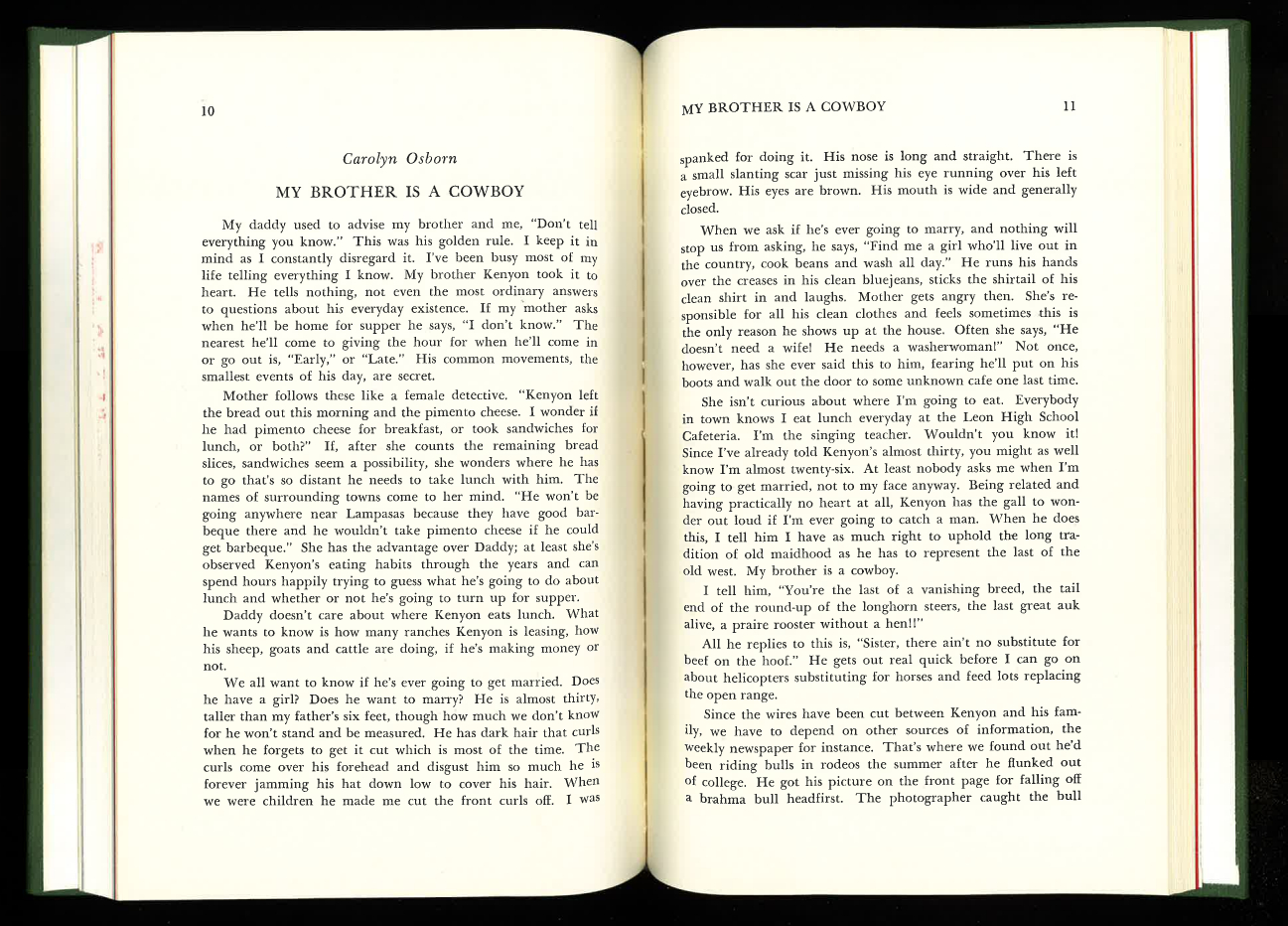
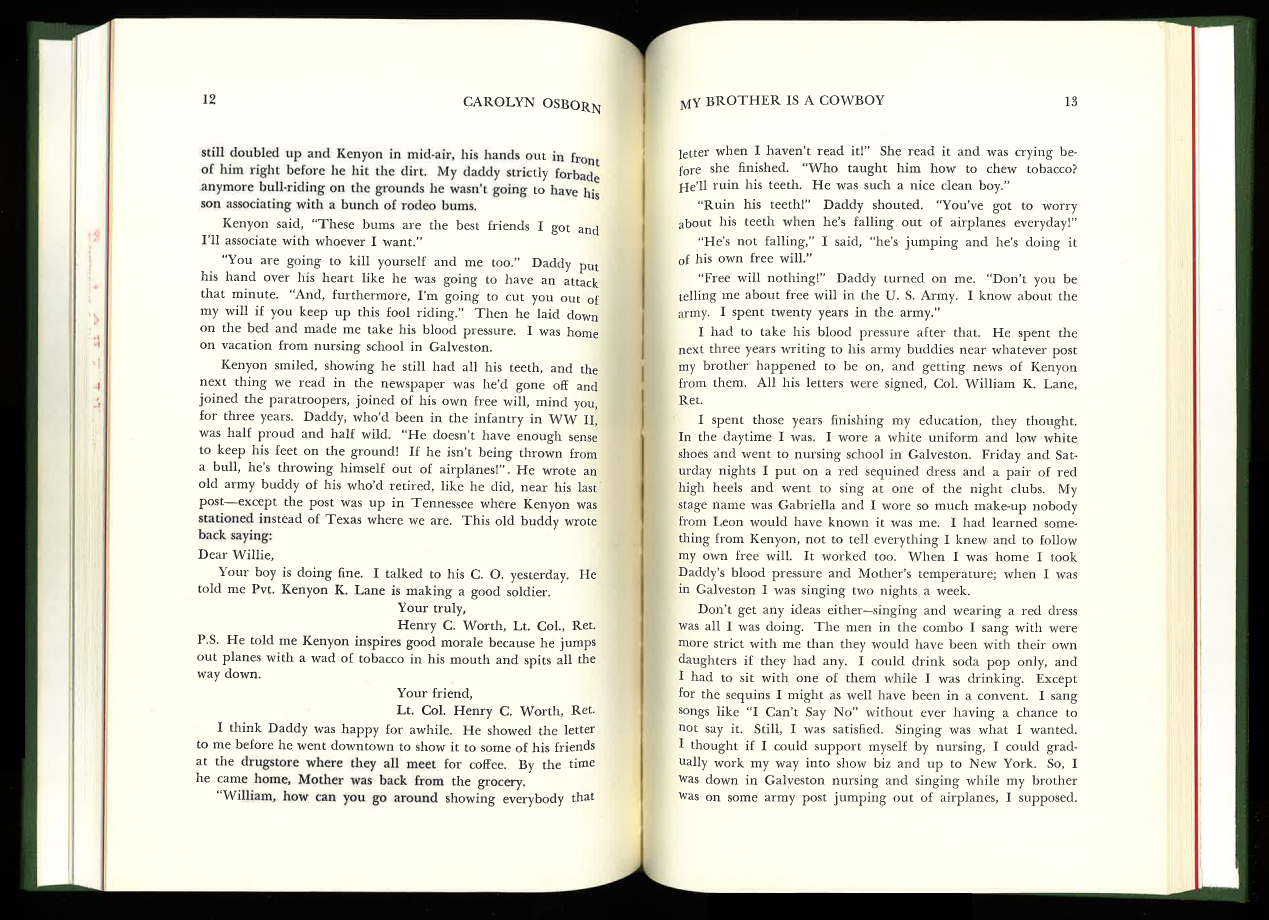
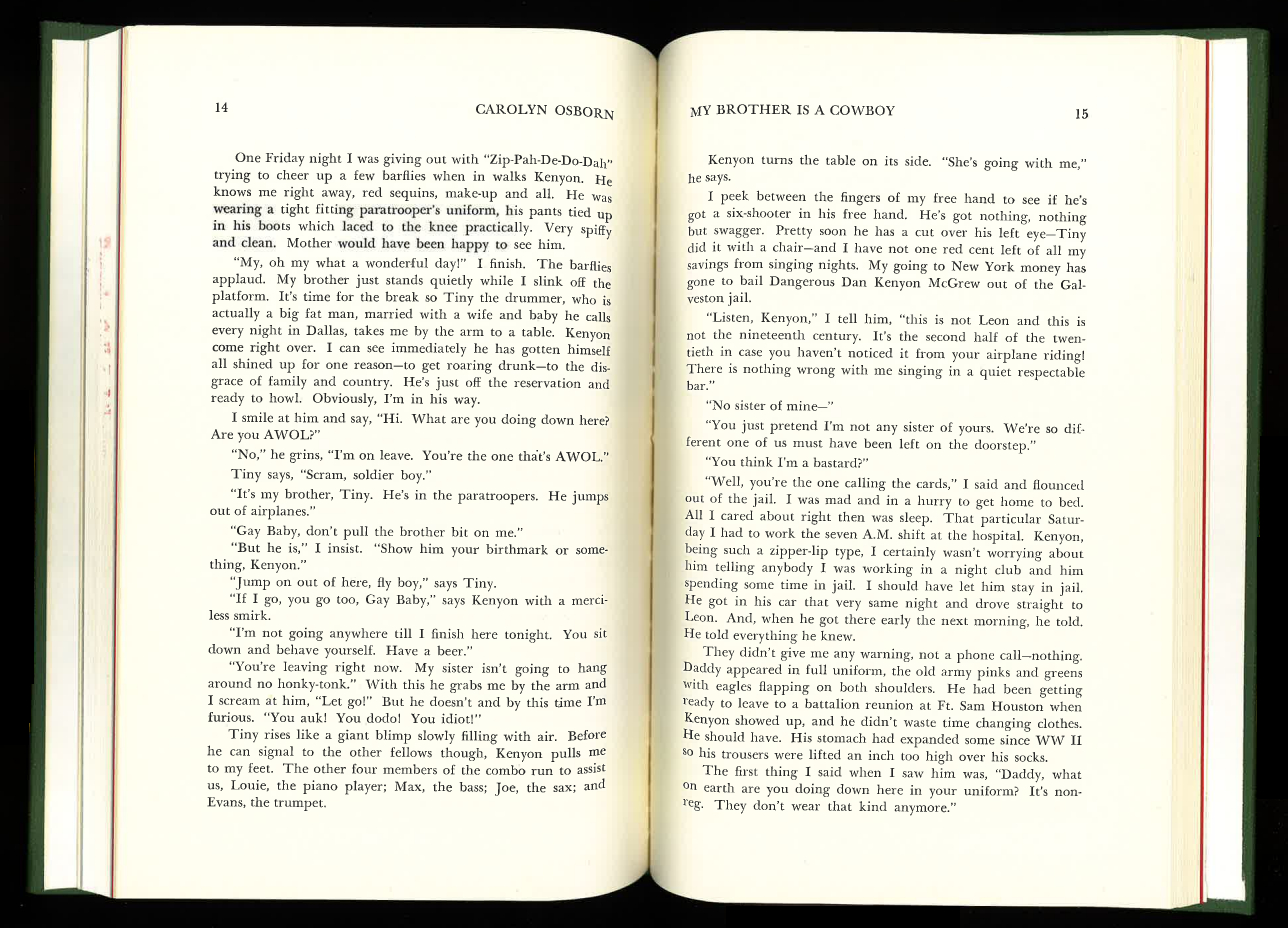
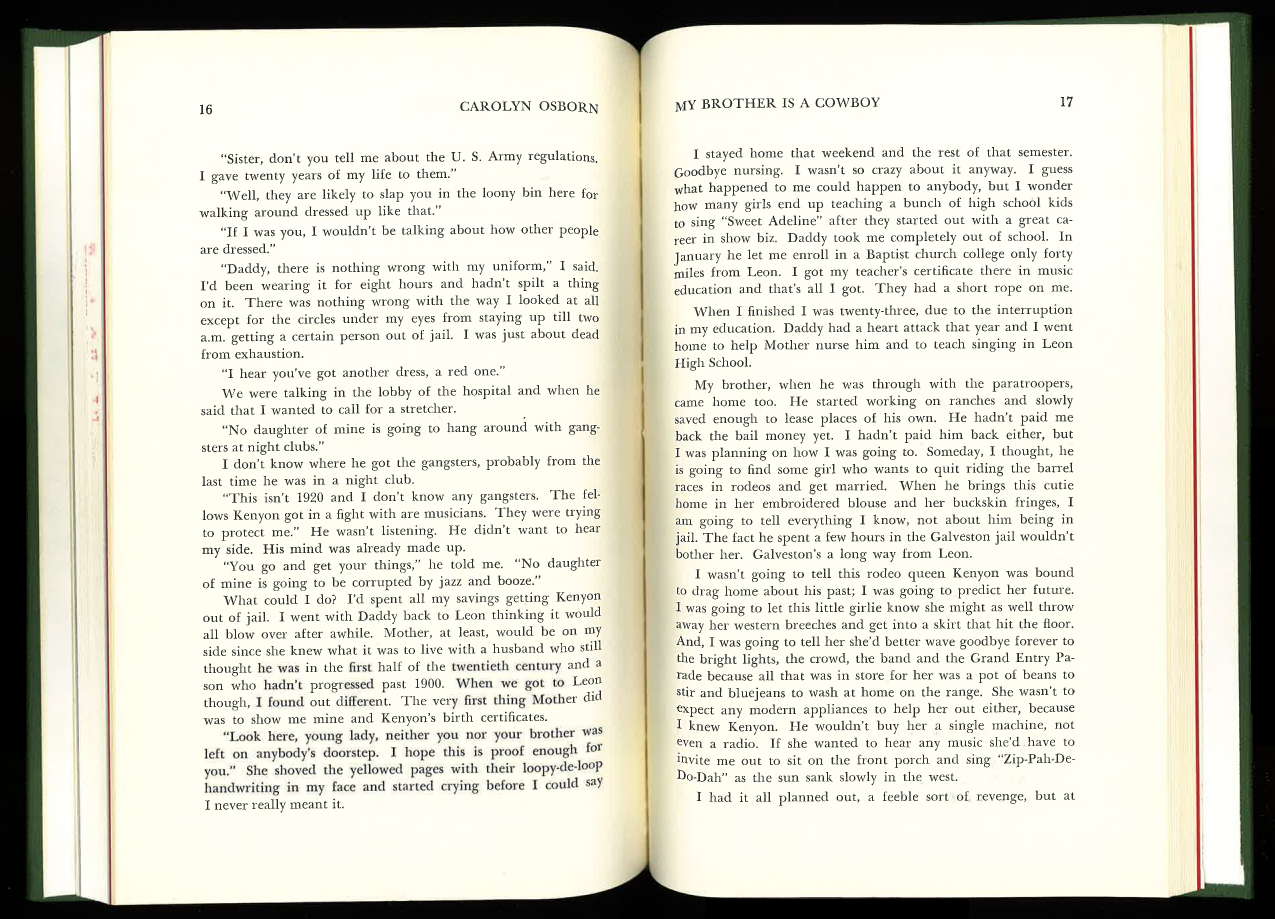
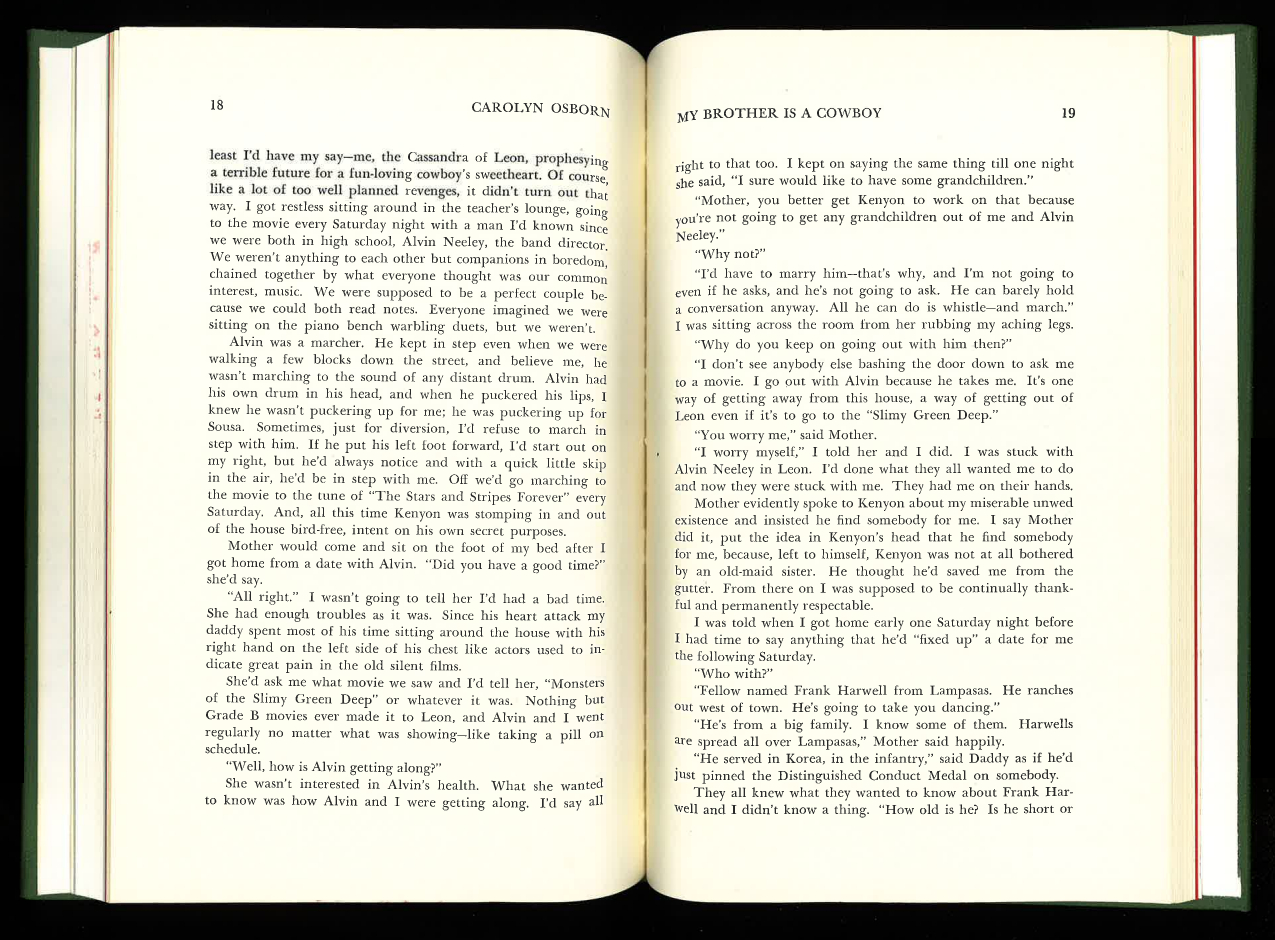
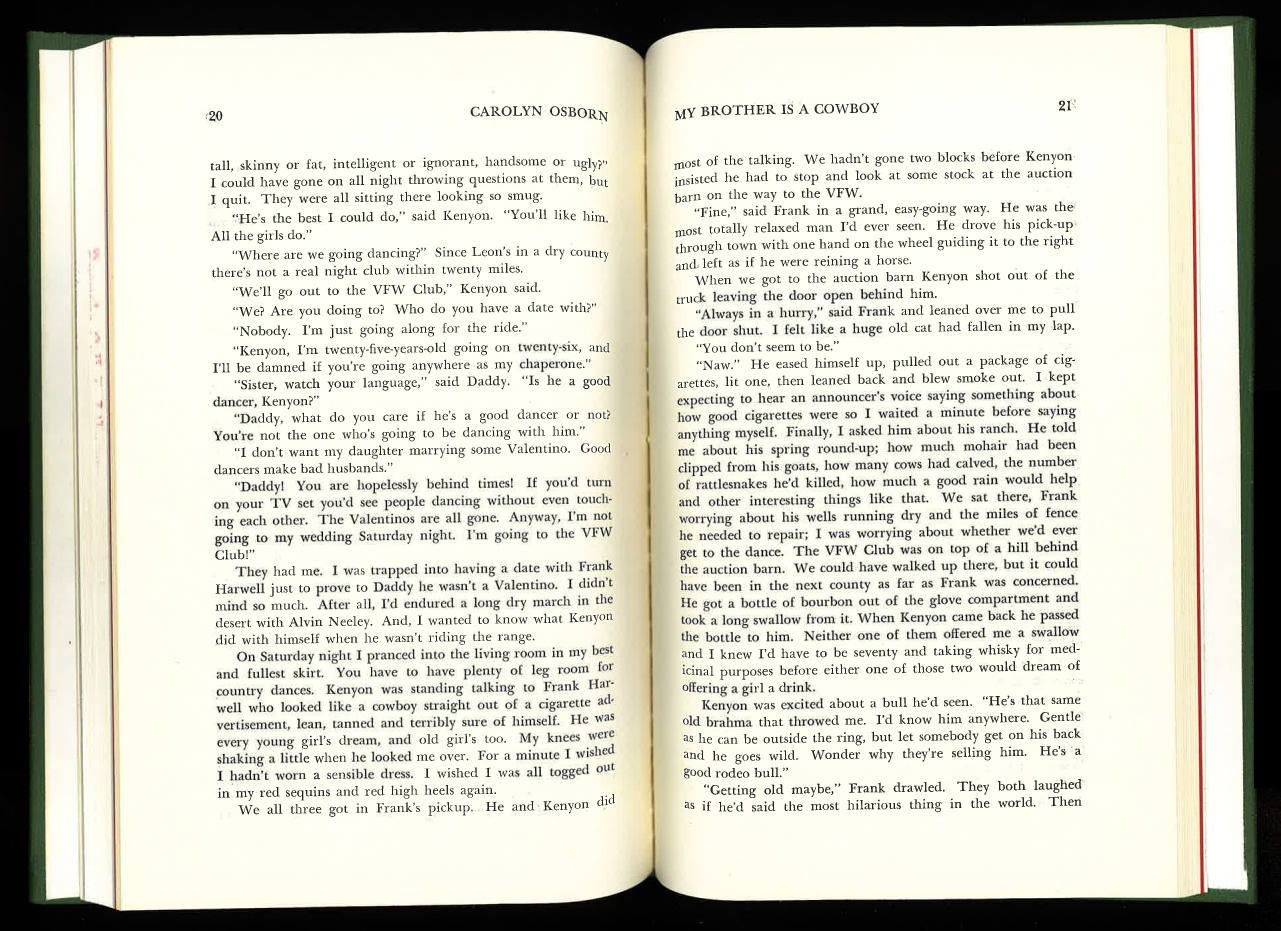
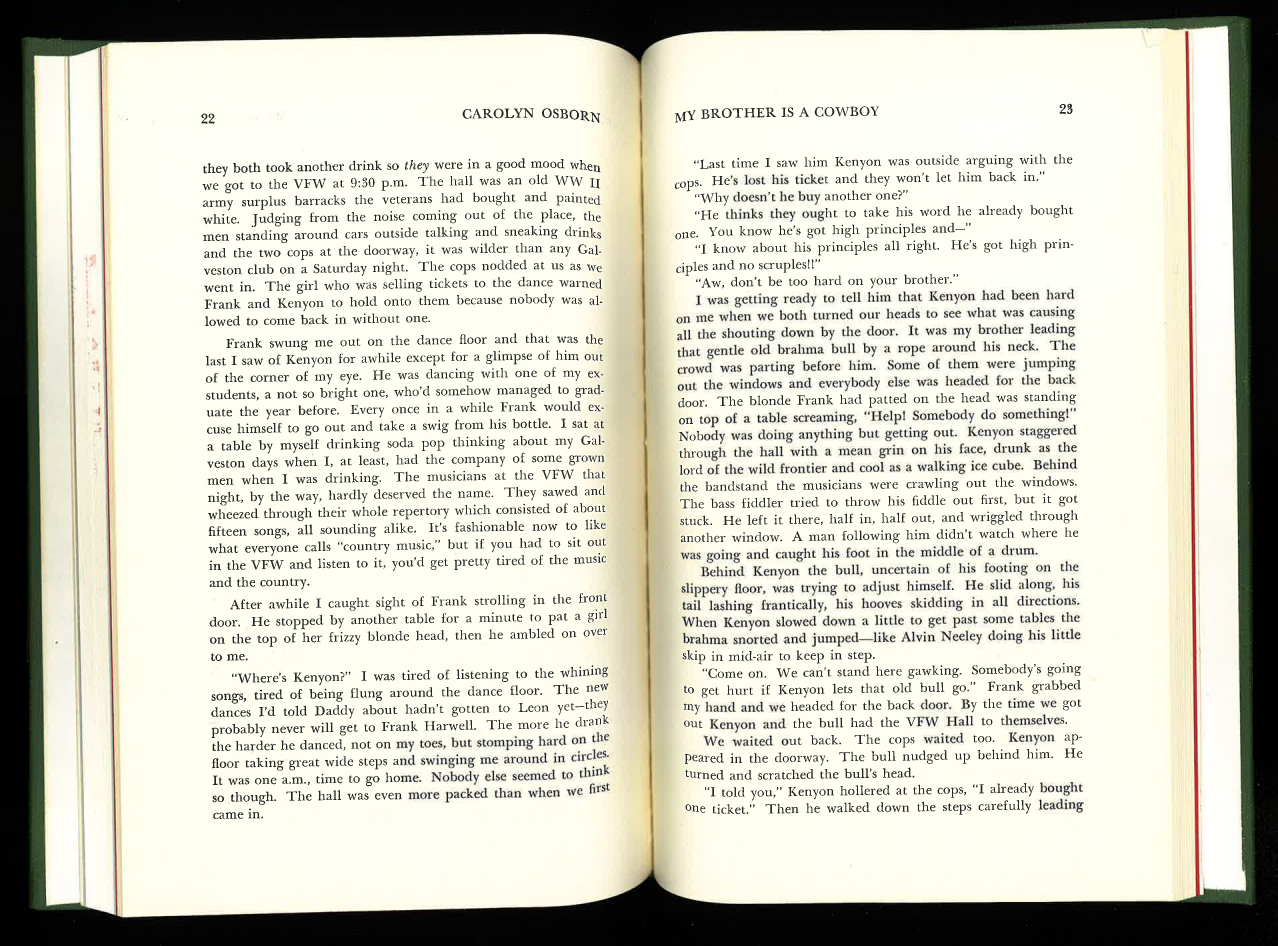
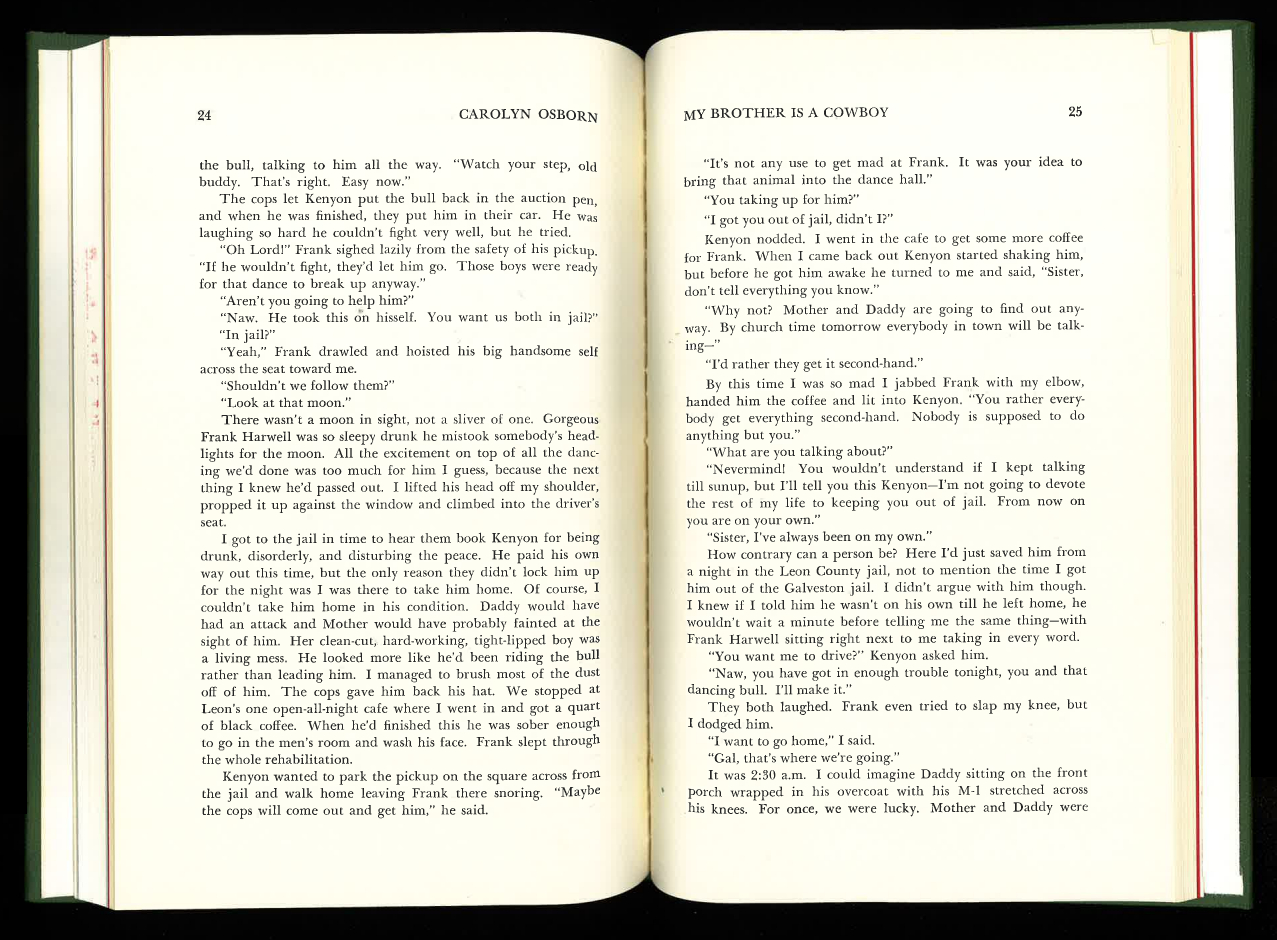
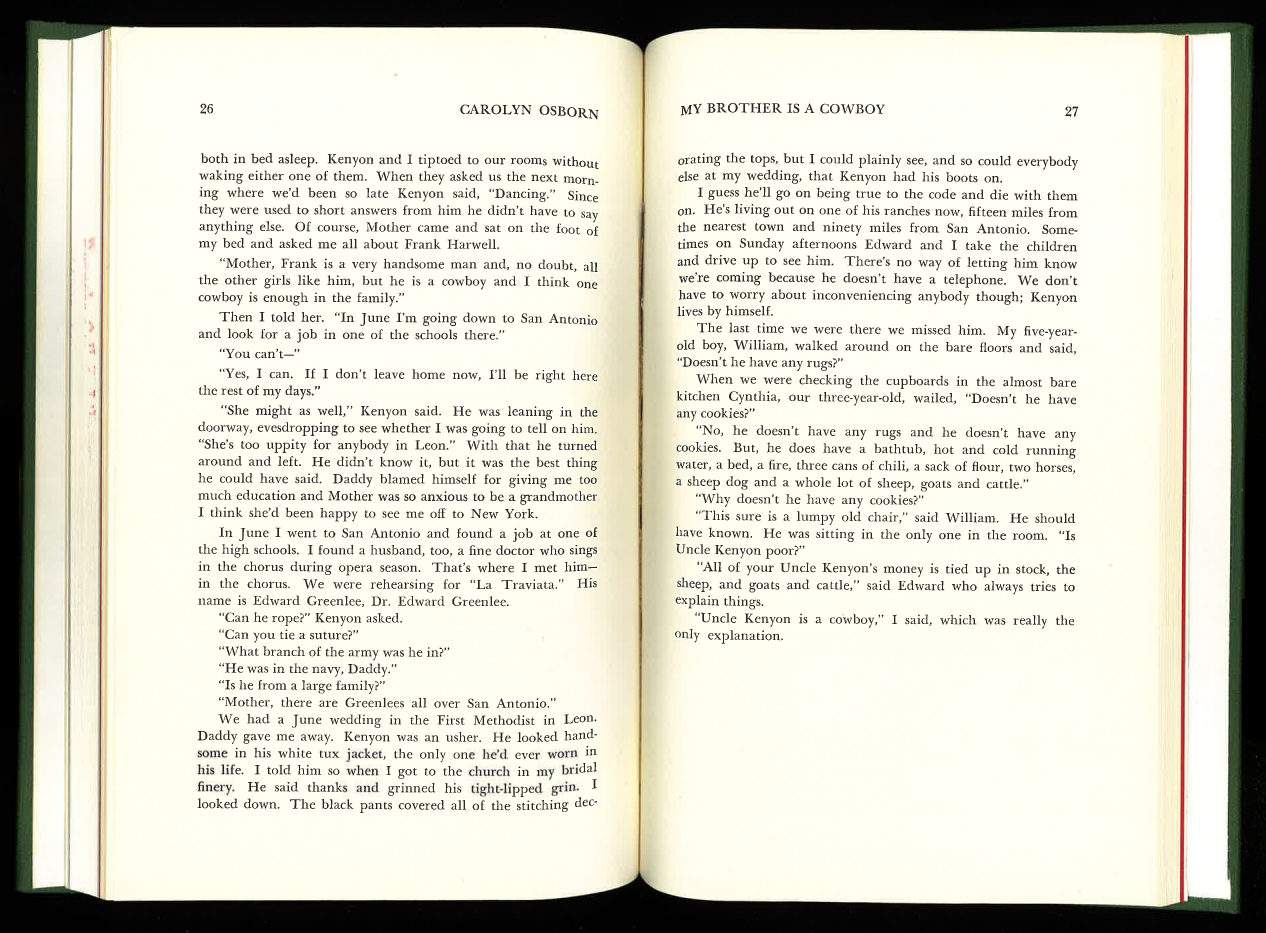
BY CAROLYN OSBORN - FROM ROANOKE REVIEW, SPRING 1970
current work
RANCHING ON DRY GROUND
“Ranching on Dry Ground” first appeared in The Missouri Review, Winter 2014.
On top of one of the mesas at the ranch at sunset while looking out above a valley toward other distant blue mesas, the view is a grandiose background for a western movie or a chorus singing, “Oh beautiful for spacious skies.” The chorus would be standing on dry ground.
This ranch I eventually inherited is, by Southwestern measures, a small one spreading over parts of Lampasas and Coryell counties in central Texas. Roughly arrow-shaped, it’s located in the northern-most hill country. From horseback in the spring the land resembles a large English park until you get down from the saddle and something bites or scratches you.
There is no running water, not a single creek, on the place. The nearest river is about three miles distant. In order to water livestock, we use rain-fed “tanks,” as ponds are called here, windmills, and springs when we can find them. We need all these sources, as the average annual rainfall, supposedly 31 inches, is just a number we refer to ironically.
When I first came to the state, I was 12, a city child who knew nothing about ranches. My stepmother began putting hers together in 1940 at the end of the Depression by buying a number of small places near Evant, her hometown, when land, which had been selling for $26 to $28 an acre, fell to $8 to $6 dollars an acre. Actually in 1942 she paid the smallest amount she would ever have to pay, only $5.76 an acre. Though prices slowly went up, she kept piecing small parcels together until she had enough to lease to her brother to run cattle on. After she married my father, he added 160 more acres Mother called “the G.I. pasture” since he bought it via the Texas Veterans’ Land Loan Program in 1957. With this addition, and 33 cares my husband, Joe, added using the same program, we thought the ranch was about 1400 acres.
Then in 1992 the Texas Land Office made the most maddening discovery: we had, in legal terminology, a vacancy. Our ranch surrounded 33.22 acres belonging to the state. Exactly how this happened—careless surveyors, bad copyists, faulty corner marks—couldn’t possibly be traced. (One 1879 survey designated a corner using “a rock mound and a Spanish oak marked E.”) If land belongs to the state, the state can sell it to anyone. When Texas joined the union, it held title to all the land originally belonging to the Spanish king, then to Mexico. To us the Texas Land Office was acting like royalty about those acres in the midst of our west pasture, the one everybody used to enter the ranch. It was as though an ancient quarrel between landlord and peasant surfaced: Mother had to purchase the state’s last hold on our land. After putting together so much cheap acreage earlier, she paid $300 an acre to buy the vacancy. It was about half of what my husband had to spend, but it wasn’t as dear since it was land locked.
Our family never actually lived on the ranch. My parents’ house in Gatesville, thirty miles east, was our headquarters. The first Christmas in Texas, four months after moving there from Tennessee, my brother, Billy, 10, and I received matching boots, factory made with red leather longhorn heads outlined in front, and reminded we were to wear them at the ranch.
We quickly learned the rules for avoiding rattlesnakes, native dwellers in our dry country; watch where you put your boots, and if you see a snake, run as fast as you can to the nearest grown-up. We spent a lot of time studying the ground. Billy threw rocks to kill rattlers. Fortunately I didn’t have to confront one until I was grown. The horse I rode, startled by a rattle, shied and without my reining him, found another path. Although the same rules applied to copperhead and coral snakes, I saw copperheads asleep on top of an old piece of metal only once. I never saw a live coral snake, the deadliest of all, though we learned the doggerel warning about its circular markings: “Red and yellow, kill a fellow. Red and black, venom lack.” Water moccasins lived in old tanks; we went swimming only in one new tank the first spring it was built, one of the few years we had ample rainfall. After Joe and I started running the ranch, we encouraged snake hunters to clear the rattlesnake dens in the mesas’ limestone rim rock. They misted the sleepy hibernating snakes with gasoline until they crawled out to escape the fumes. After collecting the snakes in tow sacks, hunters took them to rattlesnake round-ups, usually held in the spring in nearby counties. Mercifully I never had to attend one, but I’ve seen enough newspaper pictures to know men test their bravado by surrounding themselves with rattlesnakes, pushing them away with sticks, and doing other foolish things such as the recent story of someone getting in a sleeping bag with one. The young snake, full of unused venom, bit the intruder’s foot, which had to be amputated to save the man’s life. Hunters sell their largest snakes to people who concoct anti-venom, the only useful thing except men’s hatbands resulting from rattlesnakes, as far as I’m concerned, although I do know they help reduce the rodent population. And I’m also aware ecologists believe the loss of rattlesnakes upsets nature’s balance. We find their dens are repopulated, if not every year, at least every other, rattlesnakes crawl back from our pastures to hibernate in the mesas’ caves.
Scorpions, we learned as children, usually travel in pairs, “like highway patrol men,” our mother said. She was a skillful driver but prone to speeding. The name “redbug” replaced our familiar “chigger” although the bite’s formidable itch was the same and they were just as unavoidable, or so we thought. Anti-bug sprays weren’t readily available in the forties and fifties. Sometime later we learned you could swallow or bathe in a medicinal looking concoction called “flowers of sulfur” that kept redbugs away. When you sweated it made you smell so sulfurous people kept away too.
Depending on spring rains, more vigorous in the forties before our approximately seven-year drought in the fifties—from 1950 till 1957 though creeping toward us as early as 1947—wildflowers filled the pastures. In over-lapping weeks we’d see bluebonnets, orange paintbrush, yellow and red Indian blankets, yellow Mexican hats with conical-shaped green or brown centers, lavender horsemint, dark purple and lavender bluebells, tight little bouquets of mountain pinks, a field of coreopsis among the profusion of yellow flowers—so many at once that most people forget their common names and say when asked, “Oh, those are yellow flowers.” Many other varieties of flowers bloomed, of course, enough to help fill two volumes of Wildflowers of Texas. Faced with this multitude, we half forgot the short, drab winters and the cruel sun we knew would soon dominate. By 2011 our temperatures varied from 100 to 106 degrees. Around here no one goes to the country to cool off.
We can still pick Mexican plums in the early summer and gather native pecans in the fall. The tank we used for swimming the first year it was scooped out of the earth, and another for fishing, stocked with bass in the good years, dried to mud holes, then simply dried out last year. Clumps of gnarled live oak trees, post oaks, Spanish oaks, elms, walnuts, pecans, hackberries, and a dozen other varieties shade parts of pastures and despite sparse rainfall, fill ravines. For picnics in the forties, Mother favored a slope overlooking the new tank, where in the early spring or late fall she would build a small fire to heat the food, something too dangerous, and forbidden in these drought years when whole counties and those adjacent are under burn bans. On Sunday afternoons our father taught Billy how to shoot, a twenty-two, and later, a shotgun. I had no interest in shooting, or in my uncle’s steers. I’d walk in the opposite direction to find the bones of a herd of Angora goats that had died right after shearing on top of a mesa when a sudden northern blast killed them all, or to poke around the ruins of the one remaining house site and its defunct windmill in the same pasture, a perfect place for the curious to investigate. My searches yielded only old brown snuff bottles or clear sun-glazed bottles and I would wonder about the people who took the snuff, or used “Horlick’s Malted Milk Lunch Tablets,” or drank from a bottle impressed with the words, “YOU CAN’T BEAT IT,” some kind of whiskey I guessed. Did the crumbling ruin of an elevated stone cistern ever hold enough water for people to shower? Who used up all the ink in the empty inkbottle? Did anyone my age ever live there?
As much as I might want a house of our own at the ranch, we had none. Neither had Thomas H. Williams, “an indigent Texas Revolutionary war veteran” living in 1881 in Matagorda County near the Texas Gulf Coast. He was one of four veterans to acquire some of our land. Williams had to give the names of the captains he’d served under “in the year 1836 after the invasion” and prove he owned property worth $500 or less. On oath he swore he was “physically unable to support myself” and all he had was “1/2 of a 320 acre tract of land, 1 yoke of oxen, and 1 gun.” This, written in a beautiful flowing hand, just as everyone who was literate seemed to write then, on aging light brown paper, is all we know of Thomas H. Williams, for he apparently never lived on his land grant from the state; instead it was assigned to agents in Austin who sold the patent to Hyman Blum of Paris, France for an unknown price 45 years after the war with Mexico was over. Blum was evidently one of the many middle-men collecting veterans’ land certificates; he sold William’s reward for helping Texas win its revolution to local settlers for $1.00 an acre in 1901.
Slightly earlier, in 1876, another veteran, a Confederate army survivor named George W. H. McMorris, came to stay on another part of the ranch: he homesteaded 160 acres near today’s ranch’s entrance. On a site overlooking a valley beside a live oak tree he built a 14 by 14 foot log cabin with a wild mixture of logs—oak, gum, cedar, whatever was long enough—which contained a loft, and a fireplace, where he and his his wife raised three children. How five people lived in such a small space, I don’t know, but I’ve always thought the children must have been told to play outside most of the day when they were small. We’ve located the spot near the cabin where McMorris dug a well, the only available water source for his family. Since homesteads required cultivation, when the children grew older they probably worked with their father within sight of the cabin in a flat rock-strewn field made richer by soil eroding off the nearby mesa. Before barbed wire, invented in 1873, arrived in our part of the country in the 1890s perhaps they helped gather the rocks for a now toppled stone fence, but what was grown there? I’m not sure though I know cotton was the main cash crop then. If McMorris raised cotton, he must have had better rainfall in the 1870s and 1880s than we have now. Partially tumbled down with a half caved-in roof by 1946, what was left of his cabin was used to store hay for winter cattle feeding.
On a slight rise to the south of the log cabin stood the Binfords’ house, a little white wooden board and batten place probably built later by McMorris, where a family of cedar choppers, a tiny old woman and her three sons, lived. The sons were tall rangy men with weathered faces, men who seldom spoke, hired by Mother to hand chop cedar on the ranch with double-bladed axes. I didn’t fully understand their importance until my husband and I began running the ranch. In our area Ashe junipers, commonly called cedars, grow to tree size quickly and have practically no commercial value. Cattle won’t eat them and goats will nibble them away only while the trees are young. Impossible to eradicate—the seeds are continually spread by birds and animals—cedars are a water-depleting scourge as well. A 1997 A&M report shows 33.1 gallons of water per tree per day used by Ashe junipers in our area. That’s before our latest drought cycle. Many years after the Binfords’ time, Joe learned to cut down the small junipers with loppers or a chain saw, a recurrent necessity. He also continually fights mesquite, the thorny, invasive brush that thrives even more in drier south Texas. Though not as numerous as cedar here, mesquite are killed when young by spraying with a diesel-herbicide mixture in the hottest part of the summer, an extremely smelly, disagreeable task.
For the Binfords hard work with low pay was simply the cedar choppers’ lot even in earlier years when the wood was used for fence posts. Steel generally replaces cedar now, except for a few corner posts, and Anglo cedar choppers, a tribe of their own, are difficult to find; today Mexican-American crews with chain saws usually take their place.
In the forties and early fifties, I don’t know how the four Binfords all managed to live in a three-room plus screened-in back porch house with an outhouse, without electricity or plumbing except one pipe laid from the nearby windmill. The pipe bent at the house’s south wall and curled up over a windowsill to a sink. They must have had some sort of stove for heat and for Mrs. Binford to cook on. On our trips to the ranch while we were young, neither I, nor my brother were allowed to go near the house. It was off limits out of respect for the Binfords’ privacy according to our mother. I wasn’t even tempted to investigate; tall, silent red-faced men with axes were so unspeakably dangerous, they were best left alone.
Finally the Binfords drifted off, perhaps to better accommodations, or perhaps the men joined the army. My father, a World War II veteran who’d served in the Field Artillery, doubted the latter as he thought no matter how dangerous the Binford boys might have looked, they were not bright enough for service.
Billy, by the time he decided to take up ranching about 1963, moved into the Binfords’ house while retreating to Gatesville on some weekends, particularly when he needed his washing done. He was a young man at odds with formal education, an ex- paratrooper, ex-vet’s assistant, ex-livestock auction worker, ex-rodeo bull-rider. Our parents let him use the ranch lease free, but there wasn’t enough land or water to carry enough cattle and goats to make much of a profit. Gradually he would lease other places.
His years at Mother’s ranch, before he died at 36 in a one pickup wreck in 1973, were full of what seemed to me grubby necessities, but to him, they were, I think now, like the recurrent years of drought, simply part of a rancher’s life. When he hired illegal Mexican workers, as many other ranchers did in order to get by, he generally ate whatever they cooked, mostly pinto beans and rice with chilies added for flavor; some days meat from rabbits or armadillos was added. He showered by attaching a piece of hose to a spigot on the windmill, mended barbed wire fences broken by deer that hadn’t jumped quite high enough, learned to build new fences on rocky ground—another continual necessity—rode pastures checking on and doctoring cattle, designed and helped build a new corral, shored up the pole barn once again, drove to auctions to buy or sell livestock. Windmills, one of our main defenses against drought, habitually need repair. One on top of a mesa was knocked over and totally dismantled by a tornado that left the tower still standing with its fan’s blades, partially overgrown with weeds on the ground, a reason Billy often searched for springs. He discovered the best spring on the ranch at the far north end underneath a big hackberry and two large cedar elms where he found a trickle of water and piped it to run steadily to a trough connected to a another trough, connected to a third trough, all of them sitting at odd angles to each other. The trees’ trunks and limbs, metal troughs, concrete blocks, pipes and supporting wires all jumbled together, look like a working model of a contemporary art installation. It is an art to somehow manage to weave three awkward six-foot long straight troughs through three trees to make a useful watering place. Just moving those empty troughs to the site was a problem.
The spring is not easily visible from the mesa above. It’s hidden within shear rock walls and was found either by prying open a seldom-used wire gate at the northernmost corner of the ranch and hiking up to the site, or by clambering down over rocks and weeds on one side of the wall. To move the troughs in, Billy had to pry open the gate, another difficulty since it hadn’t been used for years and was so rusted he probably cut it apart and rebuilt it later.
I’m not sure exactly how he found the spring. I imagine him tying his horse to a tree on top then half-sliding, half-climbing down, as we do now, to reach the mossy wet rocks below. He could have heard tales about the spring from people in Evant, the nearest town, population 550 at its height, withered to 379 in 2010. Supposedly during the Depression, an old man lived in a tent on the mesa and used the spring below as his only water source. In our dry country, springs are to most people such a mysterious gift they incite stories. I can’t help but wonder how the old man made it through a hard winter in his tent when the wind blew down from the north so fast the temperature could drop to freezing in an hour.
After the loss of my father in 1968 and my brother in 1973, my husband and I decided to venture into a cattle partnership with my mother. For me it was a real venture since I’d never really learned much about ranching. As we grew older, the ranch definitely became my brother’s territory and I didn’t interfere. I knew, however, it was important to keep Mother occupied: she was spending too much time driving from Gatesville to visit my father’s and brother’s graves in a little country cemetery near Evant. And I slowly became more curious about how something so remote from my experience might be done. I was already involved in teaching English part time at the University of Texas in Austin, looking after three children, and writing when I could while my husband was practicing law in downtown Austin. We lived ninety miles south of the ranch. To him, an hour and a half’s drive wasn’t too far; to me the more we discussed the possibility, the more it appealed.
Joe, because he grew up on a stock farm in the Texas Panhandle, was familiar with cattle. I had it all to learn, even the basic language like cow-calf operation, which had no medical connotation: it just meant we would own cows nursing their calves approximately eight months before they were weaned and sold. The next part of the cycle was stockers, those weaned calves that were matured on wheat or grass pastures at other people’s ranches. They could be slaughtered after six or eight months producing grass-fed beef, but the majority generally moved to the feeder stage to be fattened usually in a feedlot for their last six months. My uncle and brother ran stockers, buying each fall and selling each spring. My mother, Joe, and I chose the cow-calf stage since there was less risk. The volatile beef market could leave a stocker broke if it was low at the time one had to sell. If this happened to us, we might have to take a loss on calves, but we’d still own the cows to produce more offspring another year, an optimistic view of motherhood, I decided. First we had to find the cows, but there were no herds readily available in the country nearby, and once we’d made the decision, we were in a hurry to restock.
Despite Joe’s background and familiarity with cattle, together we made one of the worst mistakes we could have; we went to south Texas to buy cows. I thought earlier it might have been a pleasure simply to leave the ranch empty of everything except wildlife, but I knew Mother wouldn’t hear of it. Unused acres are too great a luxury to those who’ve struggled to buy them and the idea of putting land to work was deeply ingrained in her generation. Joe reminded me, owners need the tax break given to agriculture use, and vacant land has its own set of problems including being a continual fire hazard. We knew how frightening a fire on dry land could be. Late one hot summer afternoon just as we drove from the ranch to the highway we saw smoke curling on the horizon. Mother, apparently intuitively aware her place was burning, led the way to the threatening gray signal, set we supposed, by the magnifying effects of sun on broken glass. With the help of the Evant Fire Department, it was quickly contained before it reached gullies covered with cedar. Because of the explosive effect of fire on the oily cedar, a disastrous spread via sparks would have been inevitable. Indians, Comanches probably, purposefully set dry grass on fire in order to attract more buffalo who preferred to eat the new green shoots; Indians obviously had neither fences to burn nor neighbors to consider. And did the cycles of drought we’ve known exist in Indian days?
We drove down to Uvalde on the border to meet a cattle owner and his agent, two men called Shirley and Carol. We already knew men called June and Francis, so in our experience the custom of giving boys girls’ names wasn’t novel, we’d just never met two of them together. Our foreman, we’d noticed, customarily named bulls after the men who sold them to us. This time we somehow forgot the sellers’ names.
After inspecting cattle from the front seat of Shirley’s pickup, we bought two bulls, a hundred mother cows, and their calves for $525 a pair, Herefords with Charolais-Hereford calves, some showing a bit of Brahma mix in the pointed tips of their ears. All of them looked good in their part of the country. We didn’t object to the mixture since, in theory, hybrid vigor results from crossing. They arrived at our place in three double-decker trucks, were unloaded, and driven to the nearest tank. It had been a good spring and all the tanks were full. I thought the windmill was working; its fan’s blades were creaking in the wind, but I soon realized no water was being pumped; the fan was simply running free while the water remained underground, my first lesson in the obduracy of windmills. First you have to know what a sucker rod is; then check closely to see if it’s moving. It’s as if windmills are made to fool anyone watching. Halfway up the tower a scissortail flycatcher, her salmon pink sides barely showing, sat on her nest, her long tail shooting west and her head turned east. Another bird’s nest was built beneath the point where the fan joined the tower. It blew to the ground as I watched, and inside I found one mottled green egg. The same day I saw two pair of quail strutting in the yard of the Binfords’ old house; soon after we jumped three jackrabbits and two cottontails; an armadillo, in its half-blind way, ambled across a corner of the pasture. Mother pointed to a horned toad sunning itself near the road, and a neighbor told us a flock of wild turkeys roosted on the east side of one of the mesas. I remembered my father hunted dove and quail on the place every fall. Since the last of Billy’s stock was removed, it seemed we’d been running a wildlife refuge. We’d spent a previous morning riding the perimeter fences of the ranch horseback and found a fawn, its spots showing in the sunlight while the doe ran off, supposedly tempting us to follow her and a female quail used the same tactic, dragging one wing on the ground to lead us away from her nest, both obeying the instinctive urge to protect their young. I leaned down by my borrowed horse’s sweaty neck to watch the almost invisible quail moving noiselessly through the grasses. On a later early morning ride we saw two bobcats bounding across a pasture. We didn’t see coyotes although we could hear them howling at night.
I would have liked to spend days riding around the ranch exploring, but we had to find a windmill man, a fast fading livelihood since submersible electric pumps are now more widely used. Floyd and Frances Parr, our new foreman and his wife, the two most indispensible people we’d found, directed us to Mr. Perkins who lived near them in Evant. Without contact with people in the area who’d lived there for years, we knew it would be impossible to run a ranch from Austin. Floyd and Frances had been raised on ranches, owned a small ranch themselves, and were willing guides.
Mr. Perkins lived in a house with a porch facing U.S. 281, the highway running from north to south through the state. First we needed to speak through the screen door to Mrs. Perkins who didn’t understand what place we were talking about.
We’d always called it “the ranch,” a futile description I soon realized, so I stated the whole connection, “I’m Mabel Winters Culbert’s daughter, Billy Culbert’s sister.”
“Oh it’s the Billy Culbert place.”
Country people have their own place designations. They forgot, or perhaps never knew, it was Mother’s ranch. Legal definitions of ownership aren’t important; who runs it is. Once this was established, Mrs. Perkins became helpful; she called around to locate Mr. Perkins while we admired her enormous vegetable garden from the front porch. The only seat was a claw-footed bathtub painted yellow, one side cut away revealing a lank cushion about six inches above the floor. In drought-ridden country, it seemed a perfect statement of décor.
Mr. Perkins, himself, looked a bit like an elf; he was a small wiry man dressed in dark green work clothes. He sat on a step, I sat next to him, and Joe hunkered on the ground. No one tried to sit in the bathtub. We soon discovered Mr. Perkins had been my mother’s student when she taught at a country school near Evant in the twenties. We often ran into someone who’d known Mother, had built a corral for my brother, worked for my uncle.
To Mr. Perkins we spoke of various windmills on the ranch and springs.
“I’d rather have a good spring than a windmill any day,” he said.
Since then I’ve heard the exact opposite said by other windmill men. Depending on their experience, they thought either a windmill or a spring tended to dry up when most needed. Now I think both do.
Mr. Perkins got our windmill running again. Just as the rest of his dwindling tribe would do in the future, he attempted to explain its inner workings including brass valves, leathers made of cowhide about the size of tablespoons to scoop up the water, and a series of long, long pipes going down to the water’s surface a hundred and ten feet below. I understood about half of what he was saying, but I did find, in the years to come, that leathers constantly wear out in our gritty limestone suffused water and require replacement, but only the windmill man seems to know exactly when. Other parts need oiling once a year at least, and the odd looking metal box covering the gears near the top is called a bonnet because of its resemblance to a woman’s old-fashioned sunbonnet, the kind my Texas grandmother had worn.
Mr. Perkins gave me two used brass valves, “to make a candlestick with,” he said.
I wondered silently how many candlesticks Mrs. Perkins had.
Shortly after the windmill was repaired and the cattle began to fill out a little, we discovered, unfortunately, some of the cows had developed a taste for prickly pear, the cactus, which grows in great numbers in south Texas and, though not quite so numerous on the ranch, is also a large problem in central Texas. Once cows eat pear with thorns burned off by flame-throwers during droughts, as south Texas ranchers often did, they can become seriously addicted to eating un-prickly pear, so will continue eating them even with thorns on. I’d been told sheep were so dumb they could smother each other to death by huddling too close together in freezing weather, but the “pear-eaters,” as Floyd called them, were I was sure, the dumb half of the dumb cow insult.
Reading information published by Texas A&M, we found prickly pear defies destruction except by the use of gallons of chemical spray or a controlled burn, illegal in a drought. The spray required a license, so we got a license and did a bit of spraying before we found we lacked enough hours to do as much as needed. And even if the burn were legal, we don’t trust the concept especially since it kills the plant only for a limited time. Now, as it threatens to overtake some pastures, we pay someone to spray prickly pear with the newest A&M recommended poison. As much as we dislike using poison, we’ll use it to save a pasture.
The pear-eaters we first bought naturally went on eating it and damaged their stomachs. Soon after we discovered some of them had a peculiar tick borne disease called anaplasmosis, which caused them to abort their calves. Trying to understand it, I read a ranchers’ magazine listing 21 ways a cow could abort; the 21st item was simply called “more.” Even when vaccinated against the disease, cows remained carriers. We eventually sold all of ours to packers, a business that “slaughtered, processed, and packed livestock into meat, meat products and by-products.” This is one of those dictionary definitions telling you less than you need to know. In the case of our cows, I suppose packers also sterilized the anaplasmosis diseased carcasses before turning them into dog food, one of the “by-products.”
We learned from Floyd and our vet that anaplasmosis existed in herds nearby, exactly whose we didn’t know, so we discovered also that ranchers can be secretive about causes of their cows’ deaths.
We began again after requesting help from the nearest U.S. Department of Agriculture office, the bank that loaned us enough money to buy more cows, and my mother who grew up helping her father ranch and was familiar with the multiple risks of raising cows and calves. This time we waited until we could buy stock from reliable local ranchers.
Touring the ranch later with one of the USDA agents, we realized our pastures were over-grazed. In this part of the country a cow and calf together require approximately 23 acres to thrive through dry and wet years. We had a horror of over-grazing. Too often we’d heard of cattlemen over-stocking a place thereby reducing the native grasses. The ranch has numerous species of grass, however our cattle principally graze buffalograss, rescuegrass, and blue grama. Unfortunately we knew we were seeing a lot of inedible broom weed, those dainty yellow flowers coloring pastures in the fall, a sure sign of over-grazed land. Because the main product of ranch land is grass, we had to save it.
We’d already finished a brush-clearing program on the G.I. land; the Binfords’ cedar chopping years didn’t include it. Our son’s three hundred Angora goats and my own multi-colored Spanish goats—at least a hundred of them—were turned loose there to eat the cedar down. Both types of goats were dual purpose; the Spanish goats’ kids were sold for meat, mainly to Chinese, Arab, and other immigrant markets while the Angora goats produced enough mohair—augmented by a generous government support price— to pay for our son’s college tuition. Unfortunately we discovered when the goats moved to other pastures in the winter they chose to eat grasses needed for cattle since the green shoots of brush they preferred were dormant. We sold all the goats. And we reduced the cow numbers from a hundred to sixty. The pastures began recovering.
In the meantime, Joe became interested in the original tall grasses grazed almost to extinction. With whatever help available, and most times alone, in McMorris’ old field he sowed Indian grass, big and little bluestem, and switch grass. We were rewarded when in the fall bluestem and Indian grass stood more than seven feet tall. Because we cut down our stock numbers, the long suppressed tall grasses, especially the little bluestem, also emerged in other parts of the ranch. My mother, who died in 1994, did not live to see the tall grasses. I’m sure she would have approved just as she approved of the log cabin restoration, the well we had drilled—run by a dependable submersible pump—and the ranch house we built with her in 1974 on the site McMorris once homesteaded.
“The 12 months from October 2010 through September 2011 were the driest for that 12 month period in Texas since 1895, when the state began keeping rainfall records.” … Austin American Statesman
This was the worst drought we’d had since Joe and I began ranching in 1973. Without spring and summer rains, grasses in our pastures weren’t growing sufficient forage, and we were running low on stock water. By 2013 we’d culled the cattle down to 52. Cows need approximately ten gallons of water a day, more or less depending on the day’s and size of the animal; bulls and cows nursing calves need more. In drought years the tanks generally dry out first, then the weak springs quit running. To compound the problem, that year our one working windmill broke, and the people we relied on for repairs proved unreliable. We’d drive up from Austin, stop in Lampasas on the way to the ranch, and confront the placid looking woman who tried to soothe us.
First: “We’ve had to order a part.”
Second: “The man who usually does this kind of work is sick.”
Third: “We’re overcome with people needing help.”
At last, after much discussion, especially since the Lampasas workers had dismantled and hauled the mill to their shop, we hired someone else to truck the broken windmill to another repair place in another county.
In 2011 our son William decided to improve a spring, one Billy had already tried to extend. Where water first seeped, as usual below a mesa’s rocks, Billy had set a pipe leading to a large concrete trough, which was generally over-flowing. To capture the over-flow, William’s workers designed an addition, a long curving native limestone wall to contain the water. From the south side the wall looked like stonework on a medieval castle. In some seasons it contained enough water to form a pond reaching to the west and spilling over in a small waterfall to the ravine below. In the driest part of the drought, all that water retreated to the old concrete trough.
To find out the volume of water in the other spring Billy discovered in the GI pasture, I held an empty quart measure under the first pipe while Joe kept his eyes on his watch. The per quart average was 32 seconds, which is 128 seconds per gallon. There are 86,400 seconds in a 24 hour day, so 86,400 divided by 128 equals 675 gallons of water per day from that spring, enough to water 67 cows a year during the worst drought we’d ever experienced.
Our only problem: There wasn’t enough grass in that small pasture to support even ten cows. Leaving the gate open wouldn’t work either because the spring was too remote from the other pastures. Salt and other minerals are easily delivered as is additional feed, but the necessity of a nearby water supply is primary.
Floyd’s spring, one he discovered in a larger pasture, and yet another spring above a pecan grove—each measuring about 474 gallons per day— have carried us through the drought so far. But for the first time since we began ranching, we are worrying about having enough water for the cattle. Drought has ruled so long we must drill another well and raise another windmill. Obviously we have spring water, however, exactly how plentiful water collected in various springs is we don’t know. All of our springs are on or near tops of mesas; according to our son’s knowledge of geology, we have typical “perched aquifers” which are trapped between a thin layer of limestone and dolomite, but these have little stored reserves unless replenished by rain. Nor do we know exactly how many others depend on the Trinity aquifer, the underground water formation in our area.
We do know more houses are being built; consequently more wells are drilled and reports from the Texas Water Development Board state the fact that pumping from the aquifer “far exceeds recharge.” So on this small ranch in Central Texas, our need for stock water from tanks, windmills, and springs continues, and our concern about climate change grows. Inflation and recreational value have driven up the price since my mother’s first purchase. What my father used to call “goat acres” in a faintly derisive tone, and where he used to hunt dove and quail, is now also valuable for deer hunting. We see few of these birds now, and like most other ranchers, are worrying about what is happening to them. Drought, disease, and the invasion of fire ants, since quail nest on the ground are the prevalent answers. On the other hand, after being hunted to extinction by original settlers by the 1890s, whitetail deer began to drift back to our country from the south. In 1967 my father happened on a deer bed, wild gasses and small plants pressed in an oval shape under one of the native pecan trees. Forty-five years later a seasonal lease can bring as much as $1500 per hunter. We never lease. Even in the midst of a record drought, we still have too many deer, hunted only by our family and friends and Frances and Floyd’s two sons. Perhaps this is a landowner’s unique form of selfishness, but it’s also a way of preventing wild shots from strangers’ guns hitting our cows and calves.
Like everyone else who owns land, we know we are only caretakers, but our ancient right to choose who will set foot on the ground remains. The old furious forms of admonition still hold: “Get out of our house! Get out of our yard! Get off our land!” We may forgive those who trespass against us, yet we state, “No trespassing.” Though the ranch is often dry, difficult to profit from, and expensive to maintain properly, it remains ours to look after until we pass the privilege to the next generation. And, unless there is a formidable climate change including far more rainfall, they will also inherit all the land’s limitations.
a note from the author
In 1970, “My Brother is a Cowboy” was my 7th published short story. My first one came out in a local magazine in 1962. I established working hours, from 9:00 a.m. till 12:00 or 1:00 p.m. when working on my M.A. degree in creative writing and tend to use those same hours now. I don’t find it any easier to get a story published now than I did then. Competition is fierce. There are many excellent story writers in the U.S. Persistence is a major virtue in this field.
I wrote on a typewriter before computers arrived, so had to learn how to use one, but I still write all first drafts by hand. There is some sort of magic happening between the hand and eye and the story. I don’t question this; it simply works best for me.
When I wrote “My Brother is a Cowboy” I was teaching part-time in the English Department at the University of Texas at Austin. The course I taught most often was called “The Modern Short Story” and began with Chekhov’s work, followed by Kafka's, Joyce's, Hemingway's, and Faulkner's plus various admirable women writers such as Porter, Welty, O’Conner, and a great many others. It was a course in comprehension, not creative writing. I learned a lot from all of them as well as from my students. I was also, with the help of my husband, raising three children, and learning how to be a rancher although we lived in Austin. In 1978, after ten years, I quit teaching in order to give more time to my own work.
As I’ve grown older, I’ve turned to writing essays, another form though kin to the short story. After all the short story evolved from the essay. I began writing at a homemade table in our bedroom, but I told myself I should be able to write anywhere including the quiet local library, rented rooms, the children’s dentist’s waiting room. Now I have an office above our garage.
Carolyn Osborn graduated from the University of Texas at Austin with a B.J. degree in 1955, and an M.A. in l959. She has won awards from P.E.N., the Texas Institute of Letters, and a Distinguished Prose Award from The Antioch Review (2003). In 2009, she received the Lon Tinkle Lifetime Achievement Award from the Texas Institute of Letters. Her stories have been included in The O. Henry Awards (Doubleday 1990) and Lone Star Literature (Norton, 2003), among numerous other anthologies. She is the author of two novels, Contrary People (Wings Press, 2012) and Uncertain Ground (Wings Press, 2009), and four collections of short stories, including A Horse of Another Color (University of Illinois Press, 1977), The Fields of Memory (Shearer Publishing, 1984), Warriors and Maidens (Texas Christian University Press, 1991) and Where We Are Now (Wings Press, 2014). The Book Club of Texas published an illustrated, specially bound edition of her story, “The Grands” (l990). Her most recent book is Durations, A Memoir and Personal Essays (Wings Press, 2017).

